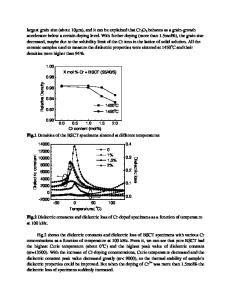Synthesis and microwave dielectric properties of CaMg 2 Si 3 O 9 ceramics
- PDF / 1,933,877 Bytes
- 8 Pages / 595.276 x 790.866 pts Page_size
- 80 Downloads / 474 Views
Synthesis and microwave dielectric properties of CaMg2Si3O9 ceramics Yan Gao1, Yong Zheng1,* 1 2
, Xuepeng Lu2,*, Zuowei Dong1, and Zheng Ke1
College of Materials Science and Technology, Nanjing University of Aeronautics and Astronautics, Nanjing 210016, China School of Materials Science and Engineering, Nanjing Institute of Technology, Nanjing 211167, China
Received: 13 July 2020
ABSTRACT
Accepted: 13 October 2020
CaMg2Si3O9 ceramics with low dielectric constant were obtained using the traditional solid-state reaction. Phase analysis, Raman spectroscopy, microstructure, and microwave dielectric properties of the CaMg2Si3O9 at different sintering temperatures were investigated. Only a single phase CaMg2Si3O9, which had the same monoclinic crystal structure as CaMgSi2O6 with a space group of C2/c, was formed in the sintered bodies and no second phases existed in ceramics when sintered at different temperatures. With sintering temperatures from 1200 to 1300 °C, the average grain size of ceramics continuously increased, and the grain size distribution became uniform. The density, Q 9 f, and the er values of CaMg2Si3O9 ceramics initially increased and subsequently decreased as the sintering temperature increased. When the sintering was conducted at 1250 °C for 4 h, the CaMg2Si3O9 ceramics showed a maximum bulk density of 3.45 g/cm3 and enhanced microwave dielectric properties of er = 7.61, Q 9 f = 41,998 GHz, and sf = - 49.8 ppm/°C.
Ó
Springer Science+Business
Media, LLC, part of Springer Nature 2020
1 Introduction Microwave dielectric ceramics are a kind of unique material that can be used in 300 MHz–300 GHz microwave band [1, 2] and are widely used in filters, resonators, dielectric antennae and other microwaverelated components as a new type of advanced materials [3]. Recently, high-performance dielectric ceramics became the research hotspot due to the rapid growth of wireless communication techniques [4, 5]. In the era of high-speed information development, high-performance microwave dielectric ceramics play an essential role in the expansion of
new telecommunication technologies, such as the fifth-generation wireless systems, industrial Internet, Internet of things, intelligent transportation or the satellite broadcasting systems [6, 7]. The rapid development of telecommunication technologies requires high quality and speed of signal transmission. In order to meet both requirements, communication technology is required to extend the working frequency to the millimeter-wave range [8, 9]. The speed of data transmission is closely connected with signal propagation and is correlated adversely with the relative dielectric constant [10]. Thus, the low dielectric constant of these ceramics can effectively
Address correspondence to E-mail: [email protected]; [email protected]
https://doi.org/10.1007/s10854-020-04671-2
J Mater Sci: Mater Electron
reduce the signal delay time and could improve the speed of transmission [11]. Therefore, low dielectric constant ceramics are of great significance for the
Data Loading...











